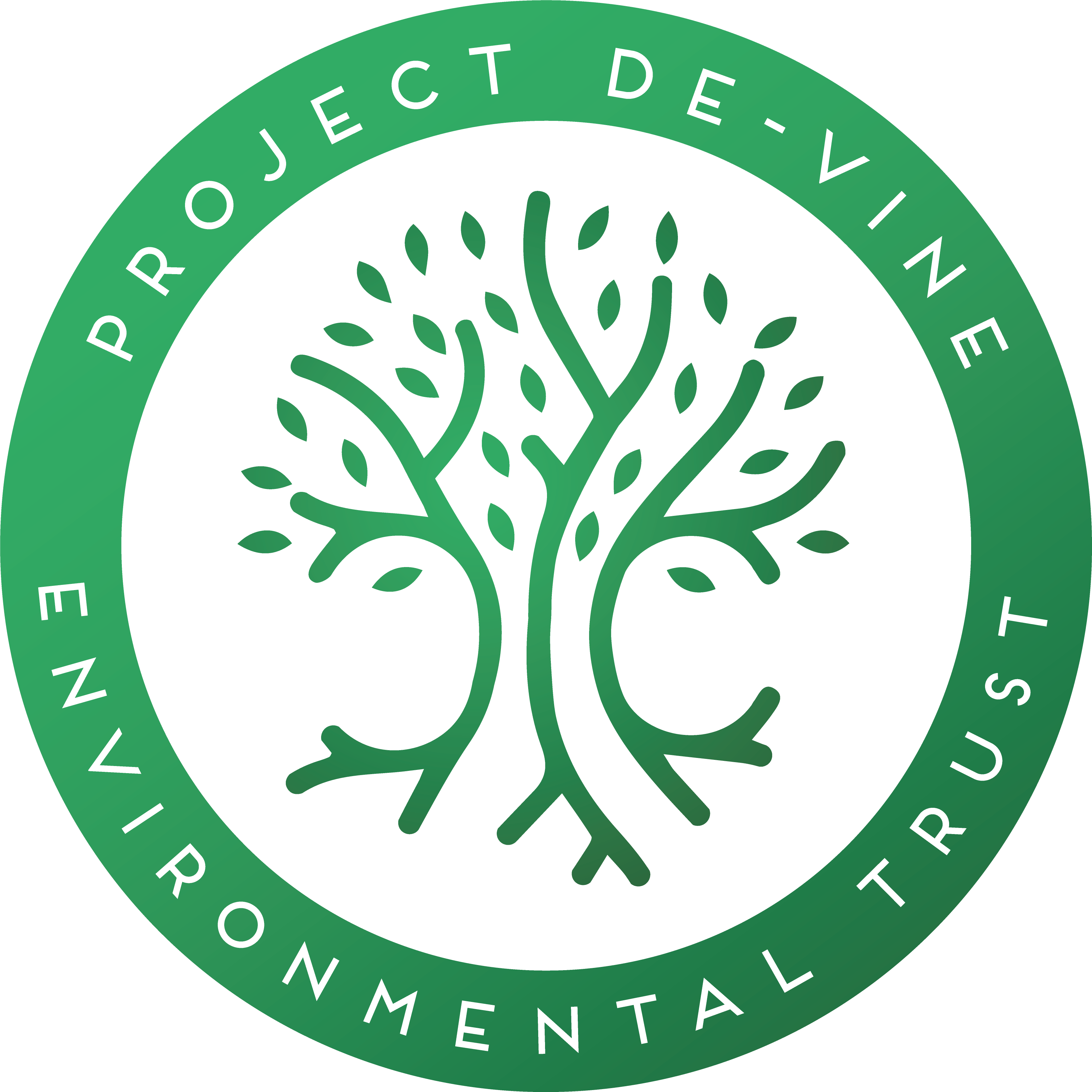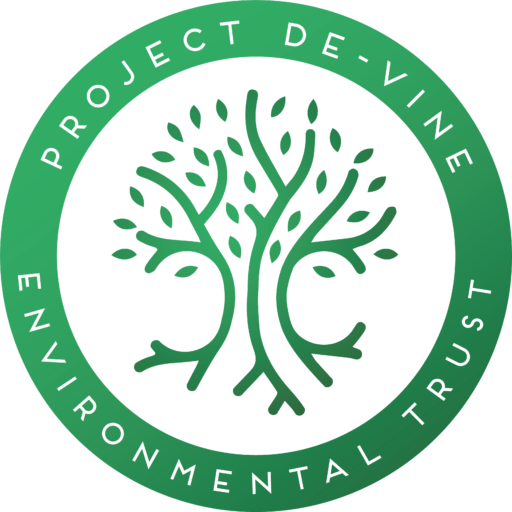
The Project De-Vine Story
Our Story
How it Started
Chris Rowse and his wife Silvia moved to Golden Bay from Christchurch in 1999. They started to clear the banana passion vines (BPV) on their property in Clifton, which had smothered and brought down trees in a gully and become well established elsewhere. Once this was under control, it became obvious that they were overwhelmed by seedlings repeatedly infesting their QEII covenanted property at Rocklands Road. Chris and Silvia set up the Rocklands Road Weedbusters group and registered it with the Golden Bay branch of with The Royal Forest and Bird Protection Society (F & B), in about 2007, with some adjoining landowners and encouraged their neighbours to help clear pest vines from their properties. They held working bees and some of the F & B members and DOC staff attended.
Chris had a bigger vision; he could see that the seedlings would keep coming until the pest vines were removed much further away from their property. In 2007, he, along with over 20 others, successfully submitted to have banana passion vine added to the Regional Pest Management Strategy for all of Golden Bay. At the RPMS hearing, he rather prophetically stated:
“I do not want to be pulling up banana passion vines on our property when I am 80!”
He could not just stop at his neighbours and has since proved to be a passionate and amazing organiser of people to tackle pest vines well beyond his locality. In 2010, on the advice of the regional representative for QEII Trust, who was visiting their covenant, he applied to the Department of Conservation Biodiversity Fund for a 3-year grant under the umbrella of the local branch of F & B who helped with the funding application and the subsequent ones up to 2016.
This was approved, and he proceeded to engage a weed team. This team worked well together on a tough karst landscape and killed thousands of pest vines on properties with sinkholes or tomos. With help from F & B, Chris turned his hand to funding applications with this success and secured two bigger grants from the same DOC fund to expand his vision as far as Pohara. Rocklands Road Weedbusters became Project De-Vine to reflect this expansion out of Rocklands Road and the Clifton area. One of F & B’s staff, David Bowden, who was responsible for looking after some if not all of their big national field projects at the time, was assigned to come down to us from time to time. He helped us establish a strategic plan for all our work including the breaking up of Golden Bay into Management units. Our reporting methodology was also developed and expanded to include our phase reporting per management unit with his support.
This support from our first beginnings allowed us to focus on the field work, completing our grants and expanding our contracting side. The local F & B committee acted as the banking arm, and the head office looked after end of year accounting and any legal queries re workers etc. Fortunately, the local DoC office and Tasman District Council from the start were and still are very supportive and give great technical backup. Project De-Vine has gone from strength to strength and became an independent charity Project De-Vine Trust (PDVT) in July 2016. F & B still supported us as needed. F & B Head Office paid for the newly formed charity to be audited from top to bottom and David Bowden oversaw the transition to completing the auditor’s requirements so that we could continue with the Lotteries grant which had been applied for, and approved, from Lotteries. The Chair, Treasurer and Minute-taker from the F & B local branch became the first trustees along with Chris. This allowed us to become a well organised charity very quickly. We are still very appreciative of all the help we received from F & B when it was most needed.
In February 2020, PDVT changed its name to Project De-Vine Environmental Trust (PDVET) to reflect the wider range of work that it is carrying out.
Project De-Vine’s Initial Goals
Its initial goals were to carry out pest plant and tree control work on prioritised species (primarily DOC’s dirty dozen) across the Golden Bay area. PDVET has gone through a rapid transition from a handful of landowners focusing on eradicating weeds from their properties in Clifton to 22 or more full time employees carrying out pest weed and tree control throughout the year. With a general manager, and the support of one full-time and part-time office administrator, and two field contractors who carry out office tasks and field management as needed, 1.44 million+ pest vines or other pest plant or tree species have been manually killed to date by our teams and many more sprayed. Over 950 properties have been assessed, and we continue assisting over 300 properties with control work.
Building a robust reporting system
Our team leaders use iPads to send in daily work updates. Our mapping system captures the tracks and data (weed points, hazards, or any data relevant to our work) in real-time from the mobile phone of each team member in the field. This data is shown in layers, and can be added or removed as required, and then used for planning and reporting to DoC, the local Council and other funders. To demonstrate the high level of pest species control, a 4-phase reporting system has been established. It shows the changes for each property where work is carried out as the targeted pest species are reduced from a heavy level of mature (seeding) plants or trees, phase ONE, to a state of only residual juvenile (non-seeding – or “zero-density”) plants or trees , phase FOUR. When this is summated for a project-funded area usually involving 200 or more properties, it is possible to get a clear picture of the properties resisting any control (usually 1, 2 or 3), to those that the landowners or we are controlling, and those that are naturally clear. As this reporting system is rolled out for all PDVET’s project areas in Golden Bay and beyond, the progress can be easily seen by funders and the Biosecurity staff of the Tasman District Council.
Raising Awareness
PDVET has raised community awareness about the damage that old man’s beard (OMB), BPV and other pest plants and trees can do to indigenous vegetation on private properties along Abel Tasman (ATNP) and Kahurangi (KNP) National Park boundaries, as well as in Reserves and regenerating bush blocks across Golden Bay and over the hill into the rest of the Tasman region. In addition, to support from a large majority of property owners, PDVET has fostered strong positive relationships with DoC, Tasman District Council, QEII Trust, Project Janszoon, LINZ, Federated Farmers and Fonterra.
A Sustainable Financial Model
Its model of being as financially sustainable as possible has still involved seeking regular grants from TDC, Rata Foundation and other sources to cover the office operating costs that are not covered by DoC, Lotteries and other funded or contract work. There is always a shortage of funding to maintain the improvements made by the funded work. In-kind support and financial contributions from landowners are always gratefully received. PDVET has been approached by individuals wishing to establish a bequest to help us with our work, which will be gratefully appreciated. Support from philanthropic sources is very welcome to help us protect Golden Bay and the halos of ATNP and KNP from weed invasions in the future. It is important to realise that Golden Bay is only 27% private land. The rest is DOC estate, either as NPs, forest parks, or reserves.
A key aspect of our work is contract work, which we charge under or close to “market rate”. This generates a “surplus”, which as a charity, we can use towards our operating costs, equipment, and starting up new initiatives.
It has taken on contract work to:
- Manage the pest vines and other key Regional Pest Management Plan (RPMP) species along the 11 rivers of Golden Bay for LINZ.
- Assist in the pest plant and tree control work in Abel Tasman National Park.
- PDVET has negotiated the contract with NZTA to clear the old man’s beard and banana passion vine from the State Highway 60 roadsides on the Riwaka and Takaka side of Takaka Hill.
- PDVET has been contracted by Tasman Environmental Trust to poison all the willows along the length of the Motupipi River and its many tributaries. It also assists with the native tree planting programme, weed control and releasing to replace them. The aim is to achieve a much better water quality outcome for the river and its estuary over a 5-year period. This has since been added to with funding for setting up wetlands and PDVET being contracted to do the mass plantings and releasing required.
- PDVET is contracted with DoC to carry out pest plant work in several of its reserves and some significant forest remnants on covenanted private properties in Golden Bay.
- PDVET has successfully worked with Tasman Environmental Trust, using the Cobb Mitigation Fund to control a mix of invasive plants established in the Takaka valley. This involves assessing many properties and then applying to other funders to co-fund the work. This is a three-stage project with 3-years of funded control work planned for each of the following:
- Lower third (finished its third year in 2021),
- Middle third (finished its third year in 2023)
- Upper third of the Takaka Valley (assessing is underway now – Nov 2023).These targeted pest species are starting to threaten Abel Tasman and Kahurangi National Park boundaries as well as lowering the effectiveness of the various riparian planting programmes that exist throughout the valley.
Other contracts are:
- with QEII for weed control of their property
- with TDC to carry out riparian planting on various projects
- with Kiwifruit Vine Health to eradicate wilding kiwifruit vines out of Golden Bay
Various TDC Departments:
- Roadside control of weeds in Golden Bay and several areas of Tasman
- Takaka Refuse Station
- Reserves in Pohara and Tata
- Pohara Water Reserve
Our Funded Work
PDVET continues to pursue its goals of making Golden Bay and the halos of ATNP and KNP free of key pest plants and trees, i.e., to reduce and maintain the targeted species to “zero-density”. Its main programme of control work on many fronts is funded by Lotteries, DOC, Rata Foundation, TDC and others. Smaller funders provide grants to allow us to assess or control areas ahead of the main control work applications. Business sponsors, the four branches of Nelson Building Society, and Cut’n’Paste Ltd, help us provide free gel bottles to landowners in our “Swap a Bottle” scheme from Nelson to Golden Bay.
See our current map of our Management Units, which shows how far we have spread across Golden Bay and over the hill from Riwaka to Marahau to complete the “halo” of control work around ATNP. We already have a provisional plan for the areas we wish to add to our areas of control so that by 2027 all areas of Golden Bay will have been assessed and hopefully have received three years of initial funded control work to the key properties subject to the level of funding. We have an annually funded follow-up control work plan to ensure that landowners are well supported, on a rotational plan, for as long as it takes to exhaust the remaining seed bank. To date, PDVET has received over $2.72 million in grants and is currently carrying out over $835k in contracted work this year.
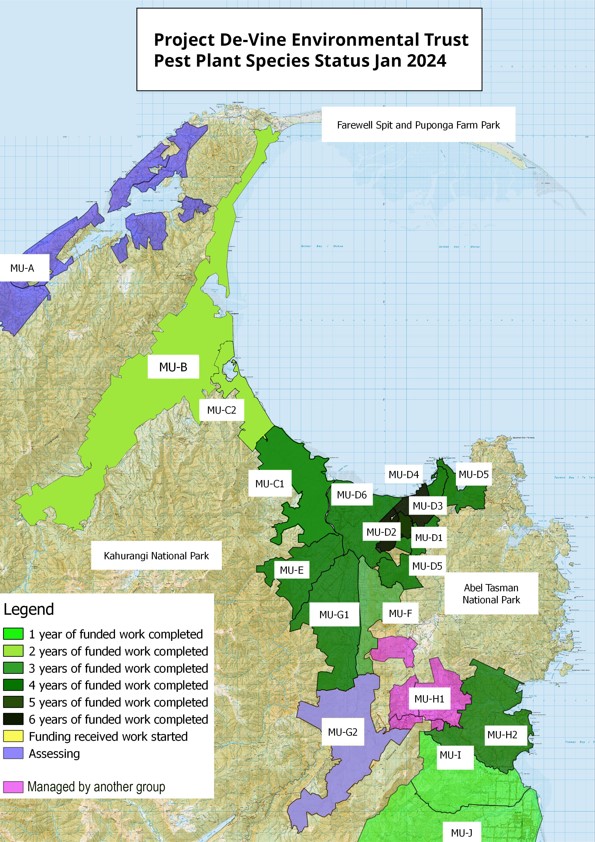
Pest species killed to the end of Oct 2023
banana passionfruit vine 836,000
old man beard 237,700
woolly nightshade 44,000+
climbing asparagus 34,000+
sycamores 47,000+
others – including taiwanese cherry and wilding pines 247,704
Total to date 1,446,404
Increase for this year (July 2022 to Oct 2023) 234,000+
Jobs for Nature Community Conservation Fund Grant (JFNCCF)
We were thrilled in June 2021 to receive the $700,000 JFNCCF grant to employ a team in Golden Bay that is advancing our invasive plant and tree, including wilding conifers, control work goals and also enable us to set up a trapping network in and around the Grove Scenic Reserve in Clifton. PDVET has trained people in a range of eco-restoration jobs, giving them a usable range of skills to continue working in this field of work.
It is for three years and will employ 3.5 FTEs per annum in Golden Bay.
We will be sending out reports to keep landowners informed of our progress on their property and its relation to our other work in their area. This will help to encourage landowners to keep up their control of these fast-growing invasive plants.
We will provide updates on our work with posts on our website and social media and press releases.
There is frequent reporting to the funders.
Staff training – growsafe and first aid will be provided for those that stay more than six months.
Darren Foxwell at Takaka DOC Office is the Delivery Manager for this contract and will oversee our work.
Finish date – three years from final signing – August 2024.
They will learn:
- a wide range of weed control skills, which will nearly complete our goal of providing three years of control work throughout Golden Bay. See attached map of management units in Golden Bay.
- kill wilding pines on a landscape scale in Golden Bay.
- set up a trapping scheme in and around the Grove Scenic Reserve
see details below:
Wilding Pine Work 2022 and 2023
PDVET has long recognized that wilding pine spread was happening in and around Golden Bay. The Trust carried out control work for QEII a few years ago in a covenanted walkway and learnt the skills required to carry out mass drilling of mature pines and control their seedlings in a very rough karst landscape.
Funding has only recently become possible for this work on a landscape scale.
With the JFNCCF grant, we have assessed over 150 properties in the halo of ATNP and KNP. This wilding pine work started in 2022 and took place in Clifton and Craigieburn in the first year. Uruwhenua and East Takaka have now been added in for this final year of the funded work.
To date 4380 pines over 1283ha have been killed.
This does includes some smaller pines that were poisoned or cut down that cannot be identified on the aerial map.
To help us do this, we created an ArcGIS wilding pine map in 2022. This allows us to track the pines across Golden Bay – including species type. We have identified where satellite visible pines are, using ArcGIS maps; this is our starting point for our work. While our teams are in the field, they can confirm these identified trees and add new ones that are not large enough to be seen from satellite photos. See the example of the map below.

Setting up a trapping scheme in and around the Grove Scenic Reserve 2021 to 2023
This has been completed with 126 traps or bait stations, using a layout designed by DOC staff. The sites are regularly visited, and the data entered into our mapping system, which has a trapping layer covering all of Tasman. See our dashboard data to date.
This is now expanding:
We started thinking about how our template could be expanded to include more and more properties. We realised that there were so many landowners and groups doing trapping of their own accord, some without any link with others and some not recording the kill data anywhere.
After talking with others in the trapping world it became apparent that there was no overall strategy or plan for the whole of Golden Bay.
So, the idea of creating the East Mohua Trapping Network was conceived. PDVET hosted a hui of all key stakeholders in Sept 2023 with TDC, DOC, iwi, Project Janszoon and local trapping representatives all meeting to come up with a plan:
The initial plan is for it to encompass from Takaka along the coast to Wainui and from Paines Ford to the Abel Tasman NP boundary and along it to Wainui. See attached.
Key participants were “Friends of East Mohua” who are already set up as a group of keen volunteers to do environmental activities, trapping, planting and weed work, from Pohara to Tata beach. They will help with the coastal areas and other work as they are able.
Now we have the plan and want to get some funding to enable this expansion. We are working with funders and also asking those interested in giving donations to go to our donation page.
If this network can get up and running, the network could expand to join up all the existing trapping networks throughout Golden Bay and create an impressive lowering of predators, which will help the released birds in ATNP and others to thrive outside the NP and future proof the work of Project Janszoon.
These three Jobs For Nature projects, inside one grant, show how valued this work is in the conservation world.
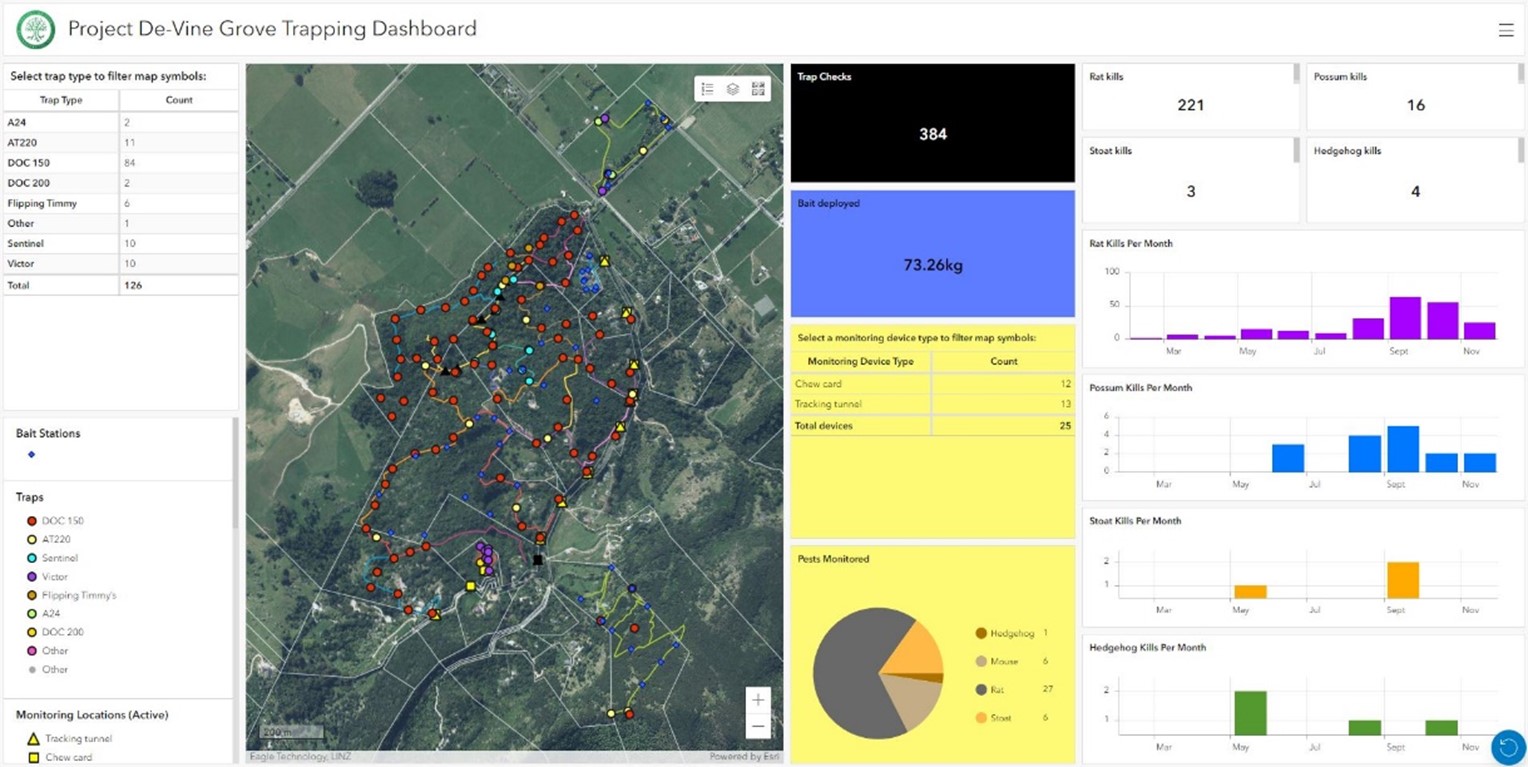
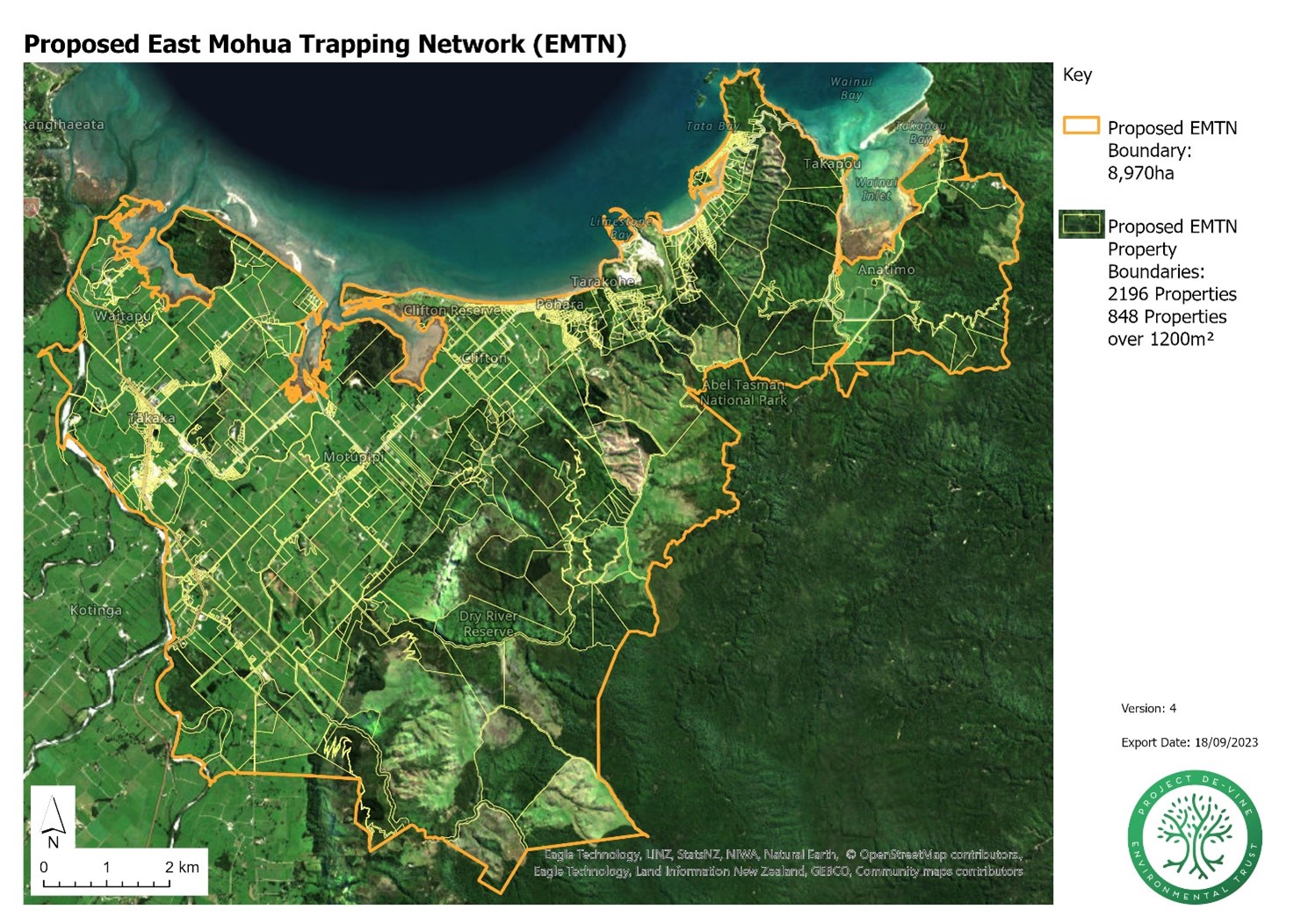
The JFNTNC contract
This project is led by the global non-profit organisation The Nature Conservancy, in conjunction with DOC, the Tasman, Nelson City, Buller, and Marlborough Councils. The project is called the “Restoring and Protecting Flora” Project. The Nature Conservancy has co-partnered with the Kotahitanga mō te Taiao Alliance – see background notes below. It involves wide-scale organised weed management across 35,000 hectares of the northern South Island and will explore the possibility of expanding the protection of some sites through QEII covenanting. Funding of $6 million through Jobs for Nature will employ 29 people with mobilised teams who can work across different locations and provide support to public and private landowners in their aim to leave an environmental legacy we can all share.
Almost $1.8 million of this funding has been contracted to Project De-Vine Environmental Trust (PDVET) and is being used in the Tasman District to carry out this work due to end in May 2024. This is a fantastic chance to assist many properties with a high biodiversity value, which would be struggling otherwise.
PDVET is contracted for three years to employ 9 FTEs – 4.5 in Golden Bay for local work and 4.5 based in Motueka for sites throughout Tasman.
One FTE is 30 hrs – PDVET is offering 37.5 hrs per week and expects to deliver about 33 hrs per week, allowing for wet weather.
Where possible, we are employing extra staff recruited from those without work in the quiet months of the tourism industry – we expect this to be in the winter months of 2022 and 2023.
The contract allows funding for a Team Manager (50%) per team + Office staff, which can include the Team Manager (50%)
The contract is to carry out weed control work directed by TNC, TDC and DOC at multiple sites throughout Tasman District.
We are employing extra staff when the opportunity arises if we need to catch up on the milestones.
We can move staff from our other Jobs for Nature contract, see above, for the winter period etc., to keep them employed.
When we work at private properties, we send out reports to inform landowners of our progress on their property and how it relates to our other work in their area. This helps to encourage landowners to keep up their control of these fast-growing invasive plants.
We are providing updates of our work in public locations with posts on our website and on social media, as well as press releases.
There is frequent reporting to the funders.
Staff training – growsafe and first aid are provided for those that stay more than six months.
Darren Foxwell at Takaka DOC Office, and Dan Chisnall at Motueka DOC office, are the Delivery Managers for this contract and are overseeing our work.
For more information, see these links:
You can use the two linked releases from DOC and Buller District Council as a guide:
https://www.doc.govt.nz/news/media-releases/2021-media-releases/teaming-up-to-protect-top-of-south/
https://bullerdc.govt.nz/jobs-for-nature-funding-awarded-for-buller/
Background information
The Nature Conservancy (external site) (TNC) is a global environmental non-profit organisation working to create a world where people and nature can thrive. Founded in the United States in 1951, TNC is involved in conservation in 72 countries and territories. TNC has partnered with Kotahitanga mō te Taiao (external site) to provide funding, science, global expertise, financial tools, and support, engaging with stakeholders.
Kotahitanga mō te Taiao Alliance was established in 2017 to work together to help nature and people thrive across Te Tauihu/ the Top of the South.
It includes Buller, Tasman, Nelson, and Marlborough councils, the West Coast Regional Council, Ngāti Apa ki te Rā Tō Trust, Te Pātaka a Ngāti Kōata Trust, Te Rūnanga o Ngāti Kuia Trust, Te Rūnanga o Ngāti Rārua, Ngāti Tama ki Te Waipounamu Trust, Te Atiawa o Te Waka-a-Māui Trust, Rangitāne o Wairau Settlement Trust, Te Rūnanga o Ngāti Waewae and the Department of Conservation.
The Nature Conservancy supports the Kotahitanga mō te Taiao Alliance to deliver on its strategy and manages the weed management Restoring and Protecting Flora Project.
The three-year project involves wide-scale strategic weed management across 35,000 hectares of the northern South Island and will employ 29 people across four districts. This includes mobile teams working across different locations providing support to public and private landowners to leave an environmental legacy.
Jobs for Nature is a $1.219 billion central government programme that manages funding across multiple government agencies to benefit the environment, people and the regions and is part of the COVID-19 recovery package.
TDC Wetlands
In 2022 we have had significant involvement in planting the Burkett Creek Wetland on Reilly’s farm. We work with TDC on several wetland restorations and developments. This is work our team enjoys being part of and hopes to be more involved with over the coming years.
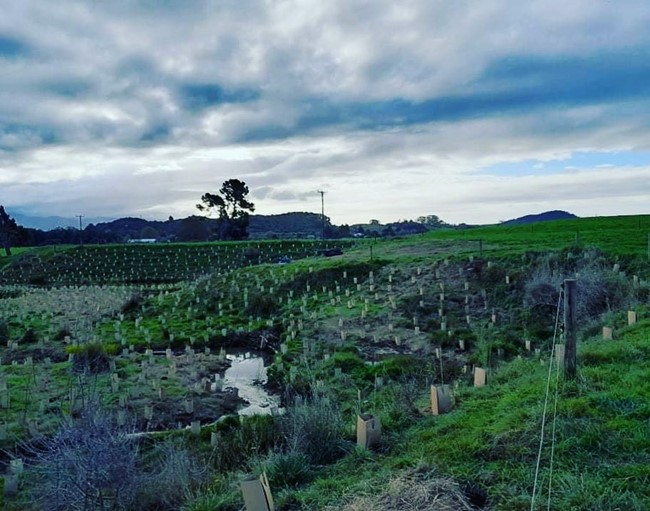
Reilly Farm
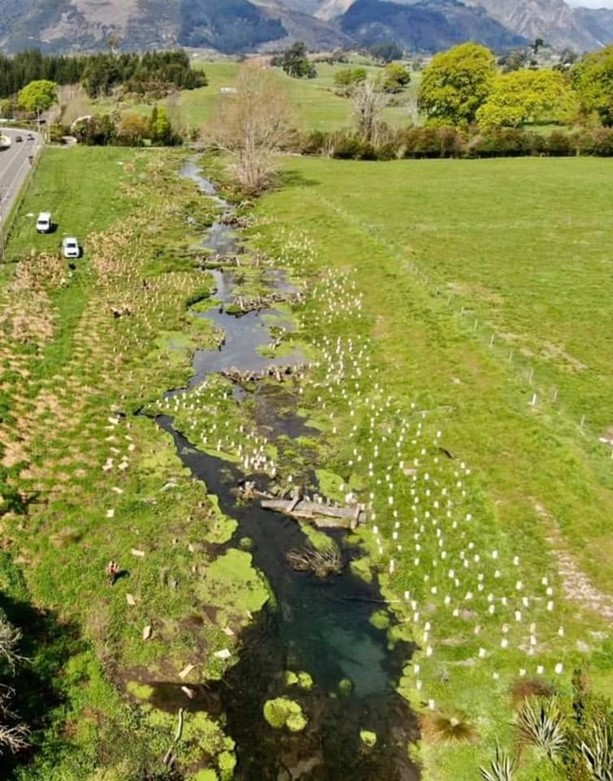
Motupipi Stream plantings
The Commissioner for the Environment released his Weeds report on 11th November 2021: “Space Invaders – A review of how New Zealand manages weeds that threaten native ecosystems”.
PDVET was very pleased to be involved as a weeding group and provided many insights into how we tackle weeds on a landscape scale.
Abridged from the press release and the report: There is a silent invasion of our forests …. Vines like banana passionfruit, old man’s beard and climbing asparagus are strangling forest understories. Wilding conifers covering hillsides.
If left to their own devices, these weeds will transform our ecosystems beyond recognition.
Defeating weeds will not be achieved by top-down policies alone. Much of the weed control happening everyday throughout the country is being done by passionate community groups, iwi, hapū and landowners.
These weeders are an integral part of this system and are making a substantial dent in the numbers of weeds carpeting and climbing over our parts of our land. In many cases they are holding the line against what would be a rapidly worsening problem.
The recommendations made in this report are intended to back up these community-based efforts. A better focused and coordinated system would give these groups the support they need to make progress and hold onto it.
Mammalian predators have captured national concern, riding a wave of predator-free initiatives around the country. No such call to arms exists on the weeds front. Despite some weeds being of concern for over 150 years, the entire system for managing exotic weeds in New Zealand appears to have never been reviewed.
(Local and central government) appear to focus on actions rather than outcomes when reporting on biodiversity management. Note: PDVET’s 4-phase reporting system (see details near the top) was established for exactly this reason; to show the change in specific weed species infestation level before and after funding work. This and other data is reported to Tasman District Council annually.
In the report, PDVET is highlighted as one of the four groups whom they have chosen to write up their work in detail. Our group is on pages 195 to 197. A defining feature of PDVET’s work is its extensive mapping database built using GIS. Employees using phones in the field can mark weed points, tracks taken through properties, and areas for future visits.
Please see the following pages regarding various aspects of our work.
Get In Touch
Have a project you’d like to partner on?
